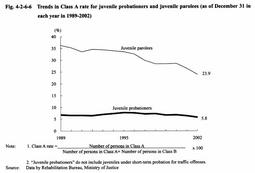| Previous Next Index Image Index Year Selection | |
|
|
4 Various treatment systems (1) Classified treatment systems The classified treatment system (see Part 2, Chapter 5, Section 3-3 ) is also implemented for juvenile probationers and juvenile parolees. Fig. 4-2-6-6 shows the percentage of "Class A" juvenile probationers and juvenile parolees, who are judged to be difficult to treat, under the classified treatment systems. As of December 31, 2002, 5.8% of juvenile probationers and 23.9% of juvenile parolees were classified into "Class A." The higher percentage for "Class A" among juvenile parolees shows that they have a number of problems in rehabilitation. For "Class A" juvenile probationers and juvenile parolees, probation officers enhance direct guidance to them as well as communicate and consult closely with volunteer probation officers in charge to provide effective treatment.
Fig. 4-2-6-6 Trends in Class A rate for juvenile probationers and juvenile parolees (as of December 31 in each year in 1989-2002) (2) Categorized treatment system As with the classified treatment system, categorized treatment (see Part 2, Chapter 5, Section 3-3 ) is also implemented for juvenile probationers and juvenile parolees. The categories relating to juveniles are abuse of thinners, etc., stimulant drug-related offenses, sexual offenses, junior high school students, unemployed juveniles, bosozoku, etc. Table 4-2-6-7 shows the percentage of juvenile probationers and juvenile parolees belonging to these categories as of December 31, 2002. For both juvenile probationers and juvenile parolees, the percentage of those belonging to bosozoku is high, followed by abuse of thinners, etc. For juvenile parolees, in particular, those belonging to bosozoku reached 30.6% and those belonging to abuse of thinners, etc. reached 18.2%. Probation offices set treatment guidelines for each category, and probation officers and voluntary probation officers implement treatment by using these guidelines. Also, some offices provide group treatment for juvenile probationers and juvenile parolees belonging to the category of drug abuse, including thinners and stimulant drugs, as well as their families, with the aim of implementing effective treatment.
Table 4-2-6-7 Percentage of juvenile probationers and juvenile parolees by category (as of December 31, 2002) (3) Short-term probation for traffic offenses Short-term probation for traffic offenses is implemented as probation decided by family court and provides for group treatment concerning careful driving, etc., for juveniles whose tendency toward traffic delinquency has not been established, instead of individual guidance by probation officers and volunteer probation officers. It also requires individual juveniles to report monthly on their living conditions in writing. Juveniles will be discharged from probation after a short period of 3 months or more but less than 4 months in principle if they do not repeat an offense while driving a vehicle. Table 4-2-6-8 shows the number of juveniles newly received under short-term probation for traffic offenses and those terminated such probation as well as the implementation of group treatment in the last 5 years.
Table 4-2-6-8 Number of juveniles newly received under short-term probation for traffic offenses and terminated such probation as well as implementation of group treatment (1998-2002) (4) Short-term probation for regular offenses Of the juveniles placed under probation by family court for offenses other than professional negligence in traffic accidents and a violation of road traffic-related laws, short-term probation for regular offenses covers those who have not markedly developed delinquent tendencies and are expected to improve and rehabilitate themselves after a short period of probationary supervision. It is implemented through individual guidance by probation officers and voluntary probation officers. It is implemented for a short period of about 6 months or more but less than 7 months. The scheme selects particularly important guidance areas for the rehabilitation of individual juveniles, such as lifestyle, school life, employment relationships, family relationships, friendship, etc., and place the focus of treatment on making juveniles perform assignments to promote redressing problems in these guidance areas.
(5) Social participation activities Social participation activities aim to promote development of social skills among juvenile probationers and juvenile parolees by prompting them to participate in various activities, including social service activities, such as assisting in nursing care in homes for the aged and cleaning activities in parks, as well as sports, and creative and hands-on activities, in addition to individual guidance by probation officers and voluntary probation officers. They are implemented mainly for juvenile probationers, and also as part of treatment for juveniles under short-term probation for regular offenses. In FY 2002, such activities were conducted 513 times nationwide (506 times in the previous year), with the participation of 1,587 juveniles (1,578 in the previous year) (Source: Data by Rehabilitation Bureau, Ministry of Justice).
|


